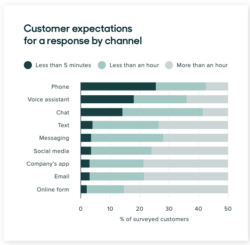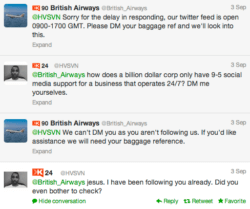A good customer service experience can drive success for your company. But a bad one can wreck your reputation. Zendesk reports that after more than one bad experience, around 80% of consumers say they’d bounce, preferring to do business with a competitor. Bad customer service drives customers away.
But a good customer experience means that customers are much more inclined to go easy on you even if another experience goes awry. According to Hubspot, 93% of customers are likely to make repeat purchases with companies who offer an excellent customer service experience.
We’re rooting for you to see that success in your company. And one of the best ways to improve your service is to learn from others’ mistakes. So we’ve gathered a few bad customer service experience stories to see what went wrong and offer what could have gone differently.
Broken Customer Service Experience 1:
The Problem: When you have really long hold times
Sitting on hold has to be one of the most aggravating customer service experiences. Nobody wants to be put on hold, especially when they need help quickly. Studies even show that 15% of customers will simply hang up after being on hold for only 40 seconds. Plus, customers expect the fastest response to be when they call you by phone. So if that expectation isn’t being met, that’s an issue.

The Scenario: I remember one horrible evening before leaving for my honeymoon, I sat on hold with an airline to figure out an issue with my flight’s ticket for nearly 2 hours. Within those two hours, my anxiety to resolve the issue only increased. After a point, it felt like my issue would never be resolved because I’d never get to actually talk to an agent. The whole interaction deterred me from ever wanting to reach out for help again.
The Solution: Long hold times are the result of a lot of possible issues: lack of training for agents, operational inefficiencies, staffing shortages. But one primary reason companies suffer from long hold times is because they haven’t sufficiently used technology to reduce inefficiencies.
Here are some ways to fix hold time:
- Use automated messaging to communicate hold times to customers so they can choose whether or not to wait it out, request a call back or hit a texting service option.
- Improve your self-service tools so customers can fix simple issues and get quick answers. With better self-service support, you’ll reduce the call volume coming into your support team so they can focus more on the customers with complicated issues.
- Deflect customers to asynchronous channels through your IVR. Customers who need immediate help then have other options to reach you — like via texting — to avoid sitting on hold. Then, have separate teams of agents for each channel ready to help.
Broken Customer Service Experience 2:
The Problem: When you lack empathy and compassion
As a customer service rep, your tone is everything. When your tone of voice on the phone or choice of language in a text, chat or email communicates annoyance or is patronizing, it’s a huge turnoff to your customers.
When customers experience an issue, they’re looking for an agent to be on their side. They want the company to apologize and accept fault. Now, I’m not saying the customer is always right, but it’s important for agents to acknowledge any inconvenience caused. If an agent doesn’t emotionally engage with the customer, that communicates a lack of care.
The Scenario: A few months ago I had an issue with my electric toothbrush. Part of the plastic had begun to crack — an expected issue after nearly a year of use. The toothbrush was under warranty, so I reached out to the customer service department to receive a replacement. I included a full explanation of the damage with photos.
The agent responded to let me know they would send a replacement, but then followed up with a long message in a condescending tone to explain to me how the crack could only have occurred as a result of something I was doing wrong in changing the batteries on the toothbrush. There was no recognition of fault in the product. This really irritated me because I had been very careful to follow their tutorials to care for the toothbrush. There has to be a better way of handling this issue.
The Solution: I assume he was trying to be helpful to avoid future damage to my toothbrush, but the interaction still bothered me as a customer and sure doesn’t make me want to have to contact them again. What could this agent have done differently?
Here’s what:
- It’s important for companies to own some of the fault. To make that interaction better, the agent could have started by apologizing for the inconvenience.
- Make every customer interaction a learning experience. I discovered that the problem with my toothbrush was a common issue with other customers. So this agent could have made this a learning experience for the product team. For instance, he could have asked for an MMS message with a picture of the broken piece so he could share with their product team. That way, they could further improve their design.
- Train agents to specifically start an interaction with compassion and empathy. Perhaps create some templates or scripts to guide agents through different scenarios. Record calls and keep transcripts to show agents good and bad examples of customer interactions to help them see how empathetic responses fit into the real world.
Broken Customer Service Experience 3:
The Problem: When you’re unwilling to receive customer feedback
Customers really hate being ignored. We have so many avenues available to offer feedback to companies. And since customers are aware that businesses are aware of their complaints, ignoring them is always worse than acknowledging them. When you don’t respond to customer feedback, that signals that you not only don’t care about your customers’ opinions, but that your customers aren’t valuable to your business.
The Scenario: One customer’s experience with British Airlines exemplifies what’s wrong with ignoring customer feedback. After the airline lost his luggage, the customer tweeted at the airline to get their attention, even promoting the tweet:

But it took eight hours for their social media team to respond! And then, in addition to this, their response was confusing.

Why would an airline that operates around the clock only provide limited hours for responding on Twitter? When an airline has lost the customer’s luggage, the expectation is that the issue is resolved as soon as possible. Brands are expected to respond to customer feedback promptly.
The Solution: Your most unhappy customers are your greatest source of learning. Customer feedback is vital for success. To avoid customers resenting you for ignoring their feedback, be on the front end and seek it out.
Here are some ways to be proactive in hearing from customers:
- Use texting to reach out to customers proactively. Texting is an incredibly reliable way to reach your customers. While emails may sit in an untouched inbox or go straight to the spam folder, texts have an open rate of 99%. Send customers surveys or feedback forms via text to get the best response.
- Add in a text support line with auto-responders and keywords to begin information collection when live support isn’t immediately available. Customers feel like they’re being proactive in seeking help and your company gathers the info you need to resolve an issue as fast as possible.
Seek feedback after every interaction. Use every conversation as a chance to hear from your customers. That way, customers can respond to the service experience they just had while it’s fresh on their mind. Automate a quick survey to send to customers after any interaction they have with you.


